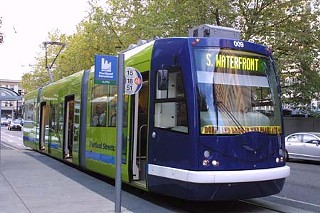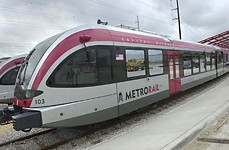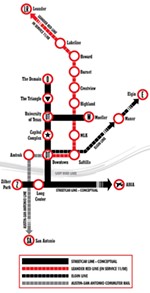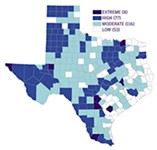Streetcar Desires
The Austin streetcar has a consensus – it could use a few champions
By Katherine Gregor, Fri., July 20, 2007

What will it take to get a streetcar system up and running in Austin?
Within that perplexing query are two interrelated questions – one about financing, the other about political coalition-building and regional partnering. Both are bigger than the streetcar project itself. As Central Texas slouches toward a regional vision to be born – for transportation, land-use planning, and the environment – big-picture solutions increasingly will demand complex partnering and financial co-investments among multiple entities. Intergovernmental and public-private collaboration on regional transit requires everyone to join hands, sing the Envision Central Texas "Kumbaya," and pony up multimillions of dollars. What better place to practice than on a small streetcar system?
"Paying for the streetcar is a microcosm of the larger financial dance that's going to continue to happen, and that will get harder and harder," says Glenn Gadbois of local nonprofit Alliance for Public Transportation.
"Solving circulator transit Downtown – call it a trolley or a streetcar – is a microcosm for the larger issues we face at Capital Metro and CAMPO [Capital Area Metropolitan Planning Organization]," Sen. Kirk Watson echoed. "If we can't solve it here, how are we going to solve the whole, much larger regional transit issues?"
To kick-start a serious financial conversation – timely for a number of reasons – Capital Metro commissioned the Austin Streetcar Financing Study. The regional transit authority had concluded from its own long-range planning that 1) circulator transit for Central Austin – for example, a streetcar system – is critically needed and broadly desired and 2) Cap Metro can't pay for it. So the transit authority proposes forming an investment club. Invited in as charter members – at a test-case $25 million to $80 million a pop – are the city of Austin, Travis County, the state of Texas, the University of Texas, Austin Independent School District (as a tax-revenue gainer, not a giver), and the private sector. The final financing study report, delivered in May by engineering consultant HDR/WHM – and first publicly released by Cap Metro for this article – presents "the basis for discussion among economic stakeholders at the local level in forming a partnership to invest in the project." (Downlaod the full study here.)
Unclear is whether the stakeholders named are ready to partner, how to strategically approach such a high-stakes negotiation, and who should lead it. But there's clearly an upswelling of heat and desire to get a deal brokered.
"I feel confident that people are starting to say, 'This makes sense! How do we pay for it?'" said streetcar advocate Wade Cooper, an attorney with Jackson Walker. "This is a once-in-a-generation opportunity. The consensus is out there. So we ought to find a way to do it."
"Does there need to be a champion that steps forward to do this?" asked Liveable City Chair Mark Yznaga. "In most communities, that's what it's taken." Indeed, numerous advocates and stakeholders interviewed for this article wished they could rub a magic lantern and have a streetcar genie emerge. The right coordinating champion could organize a strike team, with one authorized agent representing each investor group, to hammer out a co-financing consensus.
Put it on Craigslist:
Help Wanted: Streetcar Champion, Austin, TexasSkills Required:
• Passionate advocate of streetcar transit
• Visionary, excellent consensus-builder, deal-broker
• Excellent relationships with decision-makers at city, county, state, and UT, plus the private sector
• Must speak both Progressive and Bidness
Work Schedule: Next several years
Paycheck: None
Satisfaction of Community Service: Priceless
Streetcar Politics
The May emergence of the Austin Streetcar Financing Study coincides nicely with other recent forces pushing the long-stalled streetcar project to roll again. The MetroRail Red Line will deliver the first suburban rail commuters to Downtown in 2008, where they'll need "last mile" transit to get to work. ROMA Design Group's initial recommendations for the solve-it-all Downtown Austin Plan are due by year's end; they will highlight a need for circulator transit.

Cap Metro knows a streetcar project can't leave the station without political support and financial partnership from the city of Austin. For starters, Austin voters must give Cap Metro the authority to proceed. (While not formally adopted by Cap Metro's board of directors as the "locally preferred alternative" for circulator transit, a streetcar system has been the technology pursued by staff since 2004 and is widely supported as the best choice. To understand why, see "10 Reasons to Love a Streetcar."). Yet for the last year and a half, city support for the streetcar has been held political hostage by Cap Metro's persistent labor troubles. City Council members Lee Leffingwell and Brewster McCracken, who represented Austin on Cap Metro's board, would not endorse streetcar plans as a tool to motivate the transit authority to become more responsive to the transit union, now back in contract negotiations. "People just stopped talking about it; the labor issues stopped everything, and there was no conversation of any sort," Cooper said.
In March, Cap Metro finally agreed to offer labor the terms urged by the city: rights to meet-and-confer bargaining and to bargain as a unified workforce on the commuter rail projects. While those terms still have not been accepted by the union – wary of relinquishing its right to strike – apparently the offer alone freed the hostage; McCracken is enthusiastically back at work on the streetcar. (Leffingwell still believes it's unwise to hold a rail election without the full support of labor; he resigned from the Cap Metro board after only a year and was replaced in June by Mike Martinez.)
"I will be a champion for the streetcar within the city of Austin," pledged McCracken recently. "As a member of the Capital Metro board, I will also support the streetcar. However, the bulk of the energy on the streetcar system needs to be in building consensus on the financing structure. It's clear to me that leadership for creating this consensus on the financing structure will rest heavily with the city."
Toward that end, McCracken recently has been developing proposals for how the city can do its part – which Cap Metro's financing study test case floated at $80 million. The sale of the decommissioned Green Water Treatment Plant Downtown could yield $60 million-70 million for the city; all or part could be earmarked as a special endowment fund for the streetcar. In addition, Austin could dedicate revenues from the new underground parking garage planned at the site; Portland, Ore., sold bonds backed by parking revenues from city-owned parking garages to raise $28.5 million for its phase one streetcar. McCracken has gotten a favorable opinion from city legal that soaring "bed tax" funds also could be used, from the Austin Convention Center account. Together, McCracken thinks those three sources could cover the city's portion of at least a Downtown phase one line – with no new taxes.
Steadfast transit advocate Will Wynn also said he's ready to champion the Downtown circulator, "both personally and municipally." The mayor has his own complicated history (including labor mediation) with Capital Metro, which hasn't always made best use of his proffered political support. But as maestro of the Austin Climate Protection Plan, Wynn said he "desperately" wants to see Austin and its neighbors make fast progress on rail transit. "Our inability to come up with good mass-transit solutions – including the streetcar – just sticks out like a sore thumb," he said, shortly after returning from the U.S. Conference of Mayors. "Effective mass transit in this town is so soundly behind our peers – and even the smaller cities that want to be our peers."
"I think the city is going to have to play a major role, not only politically but likely financially," Wynn said. As for crafting an investment club agreement, he said, "Cap Metro probably shouldn't play that role. I think it should be a relatively small group of folks who want to see it happen. A few key members of the state delegation, key city and county officials, and at least have UT officials at the table – and go get it done! I think the stage is set to get it in front of the citizens and voters by November of 2008." Others believe the long-deferred circulator rail referendum should go to voters even sooner – this November or next May.
Progressive Yet Traditional
Speaking for the Capital Metro board, Leander Mayor John Cowman welcomed outside help. "In my opinion, we have gone as far as we can without public support and partners," Cowman said. "In looking at how other cities have built streetcars, it's clear that all the work cannot fall on the shoulders of the transit authority. You have to have both public and private parties who are willing to step up and make the project a reality."
Nationally, the bipartisan political sun is shining on streetcar systems. Recent articles in both USA Today and The Wall Street Journal discussed the dozens of cities nationwide planning new streetcar systems and neighboring transit-oriented development. Because of streetcar's positive effect on property values and overall economic development – the same effect enjoyed by American cities when they first adopted streetcar systems, early in the 20th century – it's proving popular with many conservatives as well as progressives.
"It's critically important for Austin to have a Downtown circulator. It should have been done two years ago," said Rep. Mike Krusee recently. "We desperately need to do it."
Is the Round Rock Republican ready to help broker a financing consensus with Wynn and McCracken? "I'd link arms with those guys any day of the week to get that done," said Krusee, chair of the House Transportation Committee. "Why wait until 2008?"
The Downtown Austin Alliance was the first local business organization to embrace the streetcar. Wade Cooper, a DAA advisory board member, said it has the group's enthusiastic backing as a solution to access and mobility for Downtown and as "the hub of a regional transit plan." The DAA passed a 2004 resolution calling (unsuccessfully) for inclusion of a Downtown circulator rail in that year's Cap Metro ballot proposal. The DAA passed another resolution in 2006 calling again for circulator rail and urging further study of alternate route alignments.
"There's a general sense that this would be a great thing for our community," Cooper said. "I'm not discouraged in terms of the funding. We've really just started the debate and conversation about how to fund this, to cobble together multiple revenue sources."
"It will take the whole community – the business community needs to take a leading role," Yznaga concurred. Like the DAA, he's not convinced Cap Metro's proposed alignment is the best one. But he passionately wants to get a streetcar moving – as a boon to Downtown traffic, community connectivity and mobility, environmental sustainability, oil-and-gas independence, better streetscapes, and more lively people places.
As ROMA Design Group's Jana McCann observed, in discussing how circulator transit has emerged as a common theme in multiple stakeholder group interviews for the Downtown Austin Plan: "Any time you get Liveable City and the DAA agreeing on something, you have an impressive community consensus."
Returns on Investment
Will the Austin Streetcar Financing Study prove a catalyst for turning all that rich consensus into rich project dollars? The number-crunching study by itself is not a terribly persuasive tool – which is one reason Capital Metro hasn't simply handed it around. What's required strategically is first to sell a positive vision that supports the stakeholders' own expressed agendas, rather than to lead with a price tag. As Sen. Kirk Watson observed, "There's no 'vision-absent' funding." He continued, "If you lay out a vision, then people can decide, 'Is that what we want to pay for?' Then they can back away from that, if need be, to get what they can afford."
As CAMPO chair, Watson has charged the planning organization's Peer Review Committee (chaired by Betty Dunkerley) with reviewing Capital Metro, focusing on its progress, changes, and successes from 1997 to 2007. Recommendations that emerge could inform action in the next legislative session. Watson said he's advocating through CAMPO for "methodical, systematic, transparent, and accountable processes of decision-making in all areas of transportation."
The financing study makes brief references to "broader community benefits" but narrowly focuses on selling the streetcar as a 20-year investment. For each potential investment partner, the study projects investment returns as fiscal gains – primarily driven by property-value increases projected along the streetcar line. While the national consultant's broad-brush formulas are useful, the report lacks specific understanding of the local players, their specific interests, and what would truly motivate them to participate. (For example, a "UT benefits test" optimistically tries to woo $25 million from the university by citing UT property-value increases and parking cost savings – paper gains meaningless to UT, according to Vice President Pat Clubb, because they would create no new revenue stream.) What the financing study does well is provide collaborative-financing concepts, as well as projected costs, benefits, and returns. For each potential partner, a benefits test includes fiscal impacts, suggested ranges for contributions, and possible funding sources.
It's a place to start.
A $300 Million System
The numbers in the financing study are based on Cap Metro's recommended alignment, a 6.7-mile, double-tracked line. As is the job of circulator transit, the proposed route would connect major nodes of mixed-use activity and development. The assumed route (which could be expanded later) emerged from years of community input – but isn't yet set in steel. While connectivity is king, each economic stakeholder no doubt will have relatively greater interest in getting its own segment built (see map):

A) Downtown: East-West: This segment effectively would extend the commuter MetroRail across Downtown, from the Convention Center to Seaholm and the future San Antonio rail station. If continued to Lamar, it could link to Whole Foods – a major tourist attraction and urban-dweller resource.
B) Downtown: North-South: A streetcar could replace buses running on Congress Avenue, but some prefer putting it on other streets, where it would foster redevelopment. Together, the Downtown segments total just less than 2 miles.
C) State Property: The urban desert of state parking garages could be redeveloped as lush live-work-play mixed-use, benefiting both the community and state coffers, and connect directly to the MLK museum district.
D) UT Campus: To date UT has declined to support the streetcar project; if it doesn’t invest, bet that the campus won’t get streetcar service – gutting the longer route and the Mueller connection.
E) Manor Road: A streetcar along Manor Road, connecting UT to the MetroRail line, would create a huge mixed-use redevelopment opportunity for the private sector. But it makes sense only if UT participates.
F) Mueller: Mueller is designed as a transit village, with Berkman the designated transit corridor. A stand-alone streetcar could link to MetroRail as shown, or at 51st Street.
*Segment designations are the Chronicle's.
A) across Downtown, from the Convention Center to Seaholm;
B) up Congress Avenue to the state Capitol;
C) up San Jacinto Boulevard through state-owned property to UT;
D) through the UT campus;
E) out Manor Road, intersecting with the MetroRail commuter Red Line;
F) through Mueller to 51st Street.
For that entire 6.7-mile route, Cap Metro's latest price tag is a capital cost of $210 million, plus 20-year operating costs of $90 million, for a total of $300 million (expressed in 2008 dollars). Alternately, the financing study runs the numbers for a phase one starter route – just the Downtown inverted "T" portion (A, B, C on map). That's projected at $130 million – $100 million in capital costs and $30 million in 20-year operating costs.
According to the recently published Street Smart: Streetcars and Cities in the 21st Century (see "10 Reasons"), new systems started up by other cities recently have come in at $10 million to $15 million per track mile. Assuming Cap Metro uses double tracks (for two-way traffic) along the entire 6.7-mile route, its system would have 13.4 track miles. At $210 million, that translates to $15.67 million in capital costs per track mile. The proposed Downtown-only phase one route is 1.94 miles (3.88 track miles); at $100 million, that equates to a pricier $25.77 million per track mile (due to fixed start-up costs, lost economies of scale, and disproportionate utility relocation costs).
Capital costs run higher for cities like Austin – that is, ones that don't have usable historic tracks still in place (our old streetcar tracks were pulled up decades ago) and that use new modern vehicles (which can run $800,000 each) rather than refurbished vintage streetcars (available in the $80,000 range). Still, some stakeholders question whether a sharpened pencil could be taken to the Austin system costs. "Ours is a preliminary and conservative estimate, with substantial contingencies, and precedes any engineering work to better define the costs," said Cap Metro's Todd Hemingson of the project estimates.
The Street Smart article, "Why Conservatives Should Want Streetcars," notes: "The most dangerous enemy of streetcars today is expensive overbuilding, usually driven by consultants who know nothing of traction [streetcar track] history and promote gold-plated 'high technology.' ... Confucius says, 'If consultants' figure is higher than $10 million, Heaven decrees new consultants.'"
Mueller's Time
But the main roadblock to building the entire current alignment isn't cost; it's UT's unfortunate disinclination to participate. "UT won't even discuss a route through its campus!" Krusee said. "Their attitude has been, 'We are an island.' They don't care about the quality of life of their students, or faculty and staff, on this issue. As a university, they should be open-minded, demonstrating leadership, connecting themselves to their community. But they've refused to engage. It's an outrage!"
Chop out the middle UT segment, and Mueller is left orphaned. Inexplicably absent from the financing study's short list of economic stakeholders is Catellus, Mueller's master developer. After all, the recommended route goes out to Mueller. Within its 700-plus acres, the same return-on-investment principles apply: Densities and property values could increase along the streetcar line, yielding additional tax revenues. Yet since it's such a special case, Mueller requires its own thoughtful financing solution. Matt Whelan, the lead for Catellus at Mueller, said he hadn't even heard from Cap Metro about the financing study but noted, "I'd be very interested in seeing a proposal." Whelan pointed out that because the Mueller alignment would incur no costs for right-of-way and expensive utility locations, its cost-per-track-mile will be much lower.
Mueller was designed, after all, as a transit-oriented town. The Mueller master plan "calls for alignment of the future rail through the heart of Mueller in a manner that will put the majority of residents and employees – more than 20,000 people – within a ten-minute walk of transit." Mueller first was promised light-rail; then didn't get in on the 2004 rail referendum. "[V]erbal promises were made" that rail for Mueller would be on the ballot next time Capital Metro goes to voters, confirmed Krusee, who believes Mueller is owed a proactive solution for getting a streetcar on this go-round. If necessary, it could be a stand-alone starter line that connects to the MetroRail Red Line; its streetcars could even share the commuter rail transit barn.
"How much more advocacy does Mueller have to do?" asked a frustrated Jim Walker, who's led the Mueller community involvement. "This is where we were in 2000 and again in 2004." He added, "If Mueller is left out of this one, it's going to be really hard to explain and hard for advocates of transit to support Cap Metro."
Looking for Investors
So let's swallow for the moment the whole-enchilada route at $300 million – the premise of the financing study. Paired with that financial premise is another (debatable) central concept: Cap Metro's natural investment partners for the streetcar system are the other major public-sector entities in Austin. As stewards of the region's vision of sustainable growth (ã la Envision Central Texas), the six public entities named should be motivated to step up financially to help get circulator transit built. All have a major economic stake in the region's growth – and in property values and the tax revenues they generate. In particular, the city, county, and school district could potentially enjoy significantly raised revenues from property-value increases and transit-oriented development projected along the streetcar line – in theory, enough to fund their portions of the 20-year streetcar bill.
As for the private sector, the huge economic development boon that accompanies new streetcar lines could handsomely profit landowners within three blocks of the line, as well as developers and the business and real estate communities. The financing study estimates that business and property owners along the line could receive a total financial benefit of $802 million. That would accrue from property-value increases, as well as parking and other project cost savings. If private interests collectively invested $50 million (as suggested in the test case), that could generate a 16-1 return on investment. Under the partial phase one scenario, in which the private sector is pencilled in at just $10 million, the projections show its members enjoying financial benefits of $641 million – a stunning 64-1 return.
So what's wrong with this rosy scenario? One major problem: Capital Metro isn't well-positioned to forge the investment partnership described or to win the big-ticket contributions this project needs. While it has dutifully communicated with the community and these same stakeholders over the years about the streetcar, a whole different kind of communication is required with someone from whom you're asking for $25 million or $50 million. To test the waters on its test-case contributions, Cap Metro sent staffers and a consultant to make the rounds with a simple PowerPoint. Not the right approach, nor on the right level. No wonder the transit authority was disappointed in the initial responses – described as lacking a sense of urgency. Now regrouping, Cap Metro is not quite sure where to go from here.
As a regional transportation authority – and given its particular history and current challenges – Cap Metro probably is not the right entity to broker a financing partnership for the streetcar, in any case. As Street Smart notes: "Cities champion streetcar projects more often than transit agencies do because while streetcars provide transportation, they are also tools for changing land use and promoting economic development and job generation – all areas under the purview of cities, not transit agencies."
Power Breakfast of Champions
So who should broker this deal? Just for fun, we asked around for nominations for a champion of champions – the right "outside yet inside" person to spearhead the streetcar investment club. For the ideal mix of passion, skill set, charisma, and connections, the nominee is: Wade Cooper. Upbeat on the streetcar's future, he's well-versed in the whole Austin circulator rail story, having served with Cap Metro's Future Connections advisory group. A former DAA chair (now co-chair of the DAA's Streetscapes & Transportation Committee), he's a suit from Dallas who's become a transit true believer. Active with the Alliance for Public Transportation, he's also on the board of Envision Central Texas. And as managing partner at Jackson Walker, he runs a good meeting and knows how to get things done. Spread too thin? Well, he can always share the job with fellow J-W attorney Brandon Janes – who's also thick-as-thieves over at the Greater Austin Chamber of Commerce (he went on its 2006 InterCity Visit to Portland), not to mention an APT man himself.
So pull out your BlackBerrys, ladies and gentlemen, assemble the investor strike team, and organize that weekly Power Breakfast of Champions. Austin's waiting to put a streetcar referendum on the ballot. ![]()
Got something to say on the subject? Send a letter to the editor.










